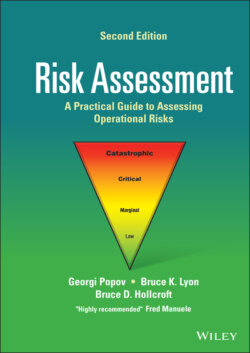Читать книгу Risk Assessment - Georgi Popov - Страница 18
1.2.5 Risk Assessment Education
ОглавлениеThe ASSP is the preferred source for education among safety and health professionals, providing valuable training and education on a variety of safety topics. As an example, our Risk Assessment Committee has established a program for safety and health professionals to earn a Risk Assessment Certificate, where they will learn to:
1 Implement the steps of the risk assessment process.
2 Conduct a risk assessment leading to the identification and prioritization of an organization’s hazards and controls.
3 Influence management to support risk reduction plans and efforts.
4 Measure the effectiveness of the risk assessment process and outcomes to support an organization’s objectives.
The Risk Assessment Committee website can be accessed at https://www.assp.org/advocacy/risk‐assessment‐committee.
Programs Related to Risk Assessment Offered by ASSP as of 5 May 2020.
1 Prevention through Design
2 Risk Assessment
3 Manage Risk Not Safety
4 Essential Risk Assessment Tools for Safety Professionals
5 Three Keys to Improving Risk Management
6 Setting the Scope and Limits of a Risk Assessment
An Example of a Guideline That Gives Risk Assessment Due Recognition
Entering https://corporate.exxonmobil.com/en/energy‐and‐environment/tools‐and‐processes/risk‐management‐and‐safety/operations‐integrity‐management‐system into the Internet will lead to a brochure on ExxonMobil’s “Operations Integrity Management System.”
Within that brochure, on page 1, there is a depiction of its Operations Integrity Management System. An adaptation of it follows (Figure 1.1).
Figure 1.1 Elements of Exxon Mobil's OIMS.
Element 1 in this 11‐point outline is what would be expected – “Management Leadership, Commitment and Accountability,” which is absolutely necessary. But note that “Risk Assessment & Management” follows item 1 immediately. That is an indication of the importance given to risk assessment within ExxonMobil operations.
And “Facilities Design & Construction” follows risk assessment immediately. That is another term for “Prevention through Design.” In the design and redesign processes, risk assessments would be made continuously as needed.
Safety professionals should not be surprised if other companies produce similar outlines as greater recognition develops that the most effective and economical method to deal with hazards and risks is to address them in the design and redesign processes.
ExxonMobil’s OIMS initiative pertains to all operational risks, including occupational, environmental, product, and public safety.
ANSI/ASSP Z590.3 – Prevention through Design: Guidelines for Addressing Occupational Hazards and Risks in Design and Redesign Processes.
This standard was previously mentioned in this chapter. It was approved by the ANSI on1 September 2011. Activities have been commenced to update this standard. Georgi Popov is the chair of the committee and Bruce Lyon is the vice chair – both principal authors of this book.
The core of prevention through design is risk assessment. Making risk assessments early in the design and redesign processes and continuously as needed throughout the life cycle of the system or product reduces the potential for incidents occurring. Logic in support of that premise follows:
1 Hazards and risks are most effectively and economically avoided, eliminated, or controlled in the design and redesign processes.
2 Hazard analysis is the most important safety process in that, if that fails, all other processes are likely to be ineffective (Johnson – p. 245).
3 Risk assessment should be the cornerstone of an operational risk management system.
4 If, through the hazard identification and analysis and risk assessment processes, specifications are developed that are applied in the procurement process so as to avoid bringing hazards and their accompanying risks into a workplace, the potential for injuries occurring is reduced greatly.
5 The entirety of purpose of those responsible for safety, regardless of their titles, is to manage their endeavors with respect to hazards so that the risks deriving from those hazards are acceptable.
The practice of safety is hazards based. Thus, Johnson wrote appropriately that hazard analysis is the most important safety process. Since all risks in an operational setting derive from hazards and since the intent of an operational risk management system is to achieve acceptable risk levels and to avoid incidents and illnesses, it follows that risk assessment should be the cornerstone of an operational risk management system.
Figure 1.2 depicts the theoretical ideal. Prevention through Design is moved upstream in the design process. The intent is to have hazards and risks analyzed and dealt with in the Conceptual and Design steps. However, that requires unattainable perfection from the people involved. Hazards and risks will also be identified in the Build, Operation, and Maintenance steps for which redesign is necessary in a retrofitting process.
Figure 1.2 Prevention through Design. With permission. Hazards Limited.
The Hazard Analysis and Risk Assessment Process is the longest section in the prevention through design standard. First, an outline of the hazard analysis and risk assessment process is given. That is followed by the “how” for each of its elements. The outline follows:
Select a risk assessment matrix
Establish the analysis parameters
Identify the hazards
Consider failure modes
Assess the severity of consequences
Determine occurrence probability
Define initial risk
Select and implement hazard avoidance, elimination, reduction, and control methods
Assess the residual risk
Risk acceptance decision‐making
Document the results
Follow‐up on actions taken
